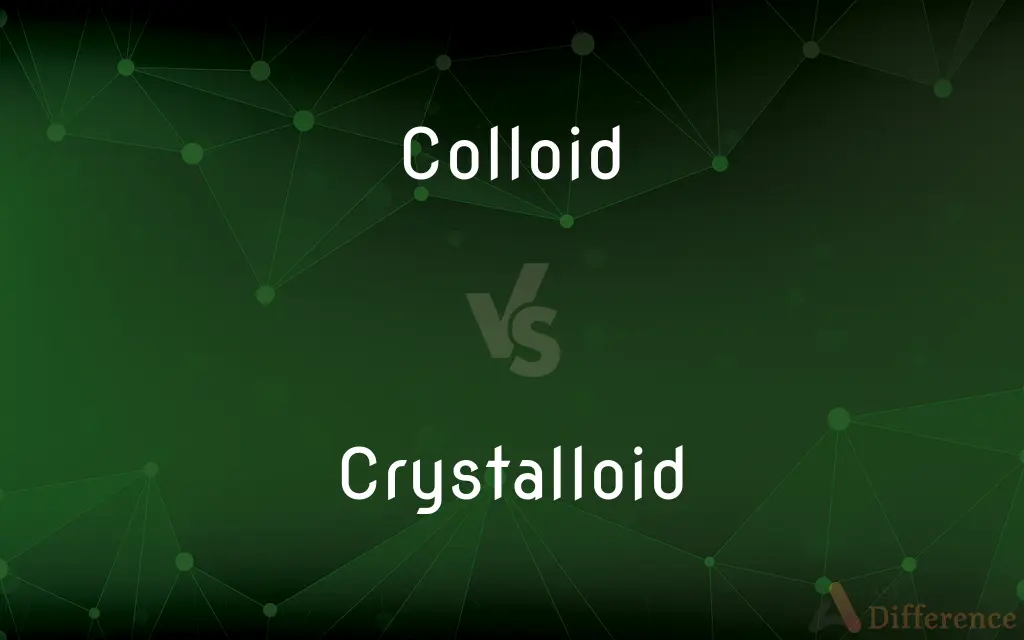Colloid vs. Crystalloid — What's the Difference?
Edited by Tayyaba Rehman — By Maham Liaqat — Updated on April 21, 2024
Colloids are mixtures where particles do not settle or separate, while crystalloids contain solutes that fully dissolve and can pass through semipermeable membranes.

Difference Between Colloid and Crystalloid
Table of Contents
ADVERTISEMENT
Key Differences
Colloids consist of microscopically dispersed insoluble particles suspended throughout another substance, often creating a cloudy appearance. In contrast, crystalloids are solutions where the solute particles are completely soluble, leading to a clear and uniform solution.
Colloids can scatter light due to the size of their particles, a phenomenon known as the Tyndall effect. On the other hand, crystalloids do not exhibit this effect because their particles are too small to scatter light.
Colloids are stable and do not settle out over time, ensuring that the particles remain evenly dispersed throughout the medium. Conversely, crystalloids are true solutions and do not have particles that can settle as everything is fully dissolved.
In medical treatments, colloids are used to manage fluid volume because they stay within the vascular compartment longer than crystalloids. Crystalloids, however, are often preferred for immediate hydration as they quickly distribute across all fluid compartments.
Colloids include substances like gels, emulsions, and foams, where the dispersion of particles creates unique textural properties. Crystalloids, such as saline solutions, do not alter texture but can affect the osmotic balance of solutions due to their dissolved ions.
ADVERTISEMENT
Comparison Chart
Particle Size
1 nm to 1000 nm
Less than 1 nm
Appearance
Cloudy or opaque
Clear and transparent
Light Scattering
Exhibits Tyndall effect
Does not exhibit Tyndall effect
Settling of Particles
Particles do not settle
No particles to settle, fully dissolved
Compare with Definitions
Colloid
A mixture where one substance of microscopically dispersed insoluble particles is suspended throughout another substance.
Milk is a colloid where fat globules are dispersed in water.
Crystalloid
Used in various industrial and scientific processes where clear solutions are required.
Crystalloids are used in laboratories for preparing precise chemical solutions.
Colloid
A substance exhibiting the Tyndall effect, where light scatters due to the size of dispersed particles.
Fog is a colloid that scatters car headlights at night.
Crystalloid
A solution where solutes are completely dissolved, forming a homogeneous mixture.
Saltwater is a crystalloid where salt is fully dissolved in water.
Colloid
Does not settle when left undisturbed, maintaining a uniform composition over time.
Paint is a colloid that remains evenly mixed even after sitting in a can.
Crystalloid
Commonly used in medical treatments for hydration and electrolyte balance.
Saline solution, a crystalloid, is administered to dehydrated patients.
Colloid
Can be classified into various forms such as gels, emulsions, and foams.
Mayonnaise is a colloid formed as an emulsion of oil and vinegar.
Crystalloid
Does not exhibit the Tyndall effect because the particles are too small.
A crystalloid like normal saline appears clear and transparent.
Colloid
A colloid is a mixture in which one substance of microscopically dispersed insoluble particles are suspended throughout another substance. However, some definitions specify that the particles must be dispersed in a liquid, and others extend the definition to include substances like aerosols and gels.
Crystalloid
Able to pass through semi-permeable membranes, affecting osmotic pressure in biological contexts.
Glucose solutions are crystalloid solutions used in intravenous feeding.
Colloid
A system in which finely divided particles, which are approximately 1 to 1,000 millimicrons in size, are dispersed within a continuous medium in a manner that prevents them from being filtered easily or settled rapidly.
Crystalloid
(Chemistry) A substance that can be crystallized.
Colloid
The particulate matter so dispersed.
Crystalloid
(Botany) Any of various minute crystallike particles consisting of protein and found in certain plant cells, especially oily seeds.
Colloid
The gelatinous stored secretion of the thyroid gland, consisting mainly of thyroglobulin.
Crystalloid
Resembling or having properties of a crystal or crystalloid.
Colloid
Gelatinous material resulting from degeneration in diseased tissue.
Crystalloid
(chemistry) Any substance that can be crystallized from solution; a water-soluble crystalline substance that can diffuse through a semipermeable membrane, as opposed to a colloid which cannot.
Colloid
Of, relating to, containing, or having the nature of a colloid.
Crystalloid
(botany) One of the microscopic particles resembling crystals, consisting of protein matter, which occur in certain plant cells.
Colloid
Glue-like; gelatinous.
Colloid tumours
Crystalloid
Crystal-like; transparent like crystal, or shaped like a crystal.
Colloid
(chemistry) A stable system of two phases, one of which is dispersed in the other in the form of very small droplets or particles.
Crystalloid
Crystal-like; transparent like crystal.
Colloid
(meteorology) An intimate mixture of two substances, one of which, called the dispersed phase (or colloid), is uniformly distributed in a finely divided state throughout the second substance, called the dispersion medium (or dispersing medium).
Crystalloid
A body which, in solution, diffuses readily through animal membranes, and generally is capable of being crystallized; - opposed to colloid.
Colloid
(geology) A particle less than 1 micron in diameter, following the Wentworth scale
Crystalloid
One of the microscopic particles resembling crystals, consisting of protein matter, which occur in certain plant cells; - called also protein crystal.
Colloid
Resembling glue or jelly; characterized by a jellylike appearance; gelatinous; as, colloid tumors.
Colloid
A substance (as albumin, gum, gelatin, etc.) which is of a gelatinous rather than a crystalline nature, and which diffuses itself through animal membranes or vegetable parchment more slowly than crystalloids do; - opposed to crystalloid.
Colloid
A gelatinous substance found in colloid degeneration and colloid cancer.
Colloid
A mixture with properties between those of a solution and fine suspension
Common Curiosities
What makes a mixture a colloid instead of a solution?
A mixture qualifies as a colloid when its particles are larger than those in a solution but small enough to remain suspended indefinitely without settling.
Can colloids be separated by conventional filtration?
Conventional filtration typically cannot separate colloidal particles due to their small size, which is large enough to be suspended but too small to be filtered out by standard methods.
Are crystalloids or colloids more effective for quick hydration?
Crystalloids are more effective for quick hydration as they distribute rapidly across all fluid compartments, including cells and interstitial spaces.
What is the impact of crystalloids on kidney function?
Crystalloids, particularly those with appropriate electrolyte compositions, are generally considered safe for the kidneys and are used to ensure adequate kidney perfusion and function.
What types of colloids are commonly used?
Common types of colloids include aerosols like fog and smoke, emulsions like milk and mayonnaise, and gels like gelatin and agar.
How do crystalloids help in medical settings?
Crystalloids are primarily used for fluid resuscitation, hydration, and electrolyte balance, making them essential in treating dehydration and supporting various physiological functions.
What are the environmental applications of colloids?
In environmental science, colloids can help in water purification processes by facilitating the removal of contaminants through coagulation and flocculation.
Why do crystalloids not show the Tyndall effect?
Crystalloids do not show the Tyndall effect because their particles are fully dissolved at the molecular level, which are too small to scatter light.
How do the stability characteristics differ between colloids and crystalloids?
Colloids are stable due to the size and interaction of particles that prevent them from settling, whereas crystalloids are stable as true solutions without any suspended particles.
How do crystalloids affect osmotic pressure?
Crystalloids can influence osmotic pressure in biological systems because their dissolved solutes contribute to the total solute concentration, affecting water movement across membranes.
What role do colloids play in the food industry?
Colloids play a crucial role in the food industry by affecting the texture, consistency, and appearance of products such as ice cream, butter, and sauces.
How do colloids affect light in photography and visual arts?
Colloids are used in photography and visual arts to create effects such as fog and mist, utilizing their ability to scatter light to enhance visual depth and texture.
What is a common misconception about crystalloids?
A common misconception about crystalloids is that they can provide the same volume expansion as colloids in medical treatments, whereas they actually distribute more widely in the body, often requiring larger volumes to achieve similar effects.
What are the risks associated with using colloids in medical treatments?
The use of colloids in medical treatments can carry risks such as altering blood coagulation, triggering allergic reactions, and affecting kidney function due to their larger particle size and complex composition.
Share Your Discovery

Previous Comparison
Dibstone vs. Dibstones
Next Comparison
Pen vs. PencilAuthor Spotlight
Written by
Maham LiaqatEdited by
Tayyaba RehmanTayyaba Rehman is a distinguished writer, currently serving as a primary contributor to askdifference.com. As a researcher in semantics and etymology, Tayyaba's passion for the complexity of languages and their distinctions has found a perfect home on the platform. Tayyaba delves into the intricacies of language, distinguishing between commonly confused words and phrases, thereby providing clarity for readers worldwide.
















































